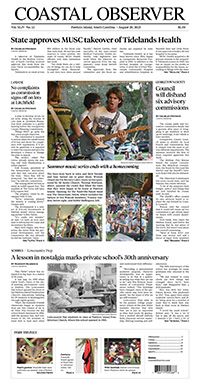Land use
Proposal would let land-use maps set density

A proposed change to the county zoning ordinance would settle a question that is now pending in a series of lawsuits over Georgetown County land use decisions.
The measure drafted by Council Member Bob Anderson would require projects in “general residential” zoning districts to comply with the density shown on the future land-use maps that are part of the county’s comprehensive plan.
“I’m just going to lay it out there and see what they do with it,” Anderson said.
A judge is scheduled to hear motions next month from the county and a developer to dismiss a suit challenging site plan approval for a 12-unit multi-family project on 2 acres on Petigru Drive. County Council approved the six duplexes in February. Keep It Green Advocacy filed suit on behalf of neighbors and citizens groups saying the property should be developed as “medium density” in accordance with the future land-use maps rather that “high density” as allowed by the current “general residential” zoning.
The county considers anything over five units an acre to be high density, with a maximum of 16 units an acre permitted for efficiency apartments.
Last week, a Circuit Court judge granted motions to dismiss another suit filed by Keep It Green Advocacy seeking to overturn a zoning change to allow 90 townhouses on 14.4 acres originally planned for a tech park. The judge’s decision appeared on a form with a note that the attorneys for the county and its Alliance of Economic Development, which owns the property, would prepare formal orders.
Two other suits are pending.
Anderson sent his proposal to his council colleagues, the Planning Commission and county staff. It would add a paragraph to the current “general residential” section of the ordinance: “All projects, site plans, developments and permitted uses under this ordinance shall comply with the Georgetown County Comprehensive Plan and net residential density shall comply with Future Land Use Map density requirements.”
That will allow the county to comply with state law without having to rezone individual parcels, he said.
Anderson traces the origin of the current problems to 1994 when state law changed to require local governments to create a comprehensive plan. Land use is one of the elements of that plan and zoning is required to reflect future land-use maps.
That was never done, Anderson said, adding that he researched the county’s records back to 2000. State law required that the comprehensive plan be reviewed every five years and updated every 10 years. The county’s last review of the land-use element was in 2015. An update is expected by the end of this year.
While the county hasn’t initiated wholesale zoning changes, Holly Richardson, the county planning director, said it has made changes in residential zoning in cases where property owners requested it.
She said the county attorney is reviewing Anderson’s proposal. It is not on the agenda for the Planning Commission meeting this month.
This isn’t Anderson’s first attempt to reduce density by changing the zoning ordinance. Last year, he proposed amending the “general residential” requirements to require that development on tracts of 3 acres or more with more than 10 units maintain 50 percent of the land as open space. The amendment would only apply on Waccamaw Neck.
The Planning Commission deferred action on the proposal.
“People in Parkersville, at that time, did not like that,” Anderson said. “They’re ready now.”
Three of the four developments being challenged in court are in the Parkersville area.




